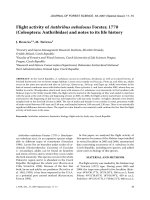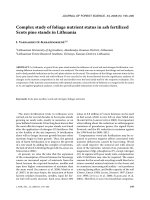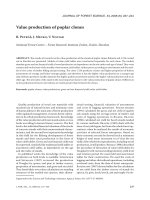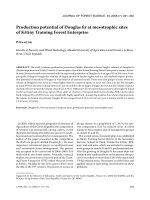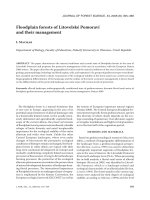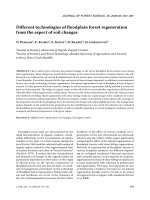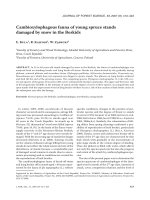Báo cáo lâm nghiệp: "Relative efficiency of alternative methods to evaluate wood stiffness in the frame of hybrid larch (Larix × eurolepis Henry) clonal selection" potx
Bạn đang xem bản rút gọn của tài liệu. Xem và tải ngay bản đầy đủ của tài liệu tại đây (217.94 KB, 9 trang )
35
Ann. For. Sci. 61 (2004) 35–43
© INRA, EDP Sciences, 2004
DOI: 10.1051/forest:2003082
Original article
Relative efficiency of alternative methods to evaluate wood stiffness
in the frame of hybrid larch (Larix × eurolepis Henry) clonal selection
Dominique JACQUES*, Michèle MARCHAL, Yannick CURNEL
Centre de Recherche de la Nature, des Forêts et du Bois, Ministère de la Région Wallonne, DGRNE, avenue Maréchal Juin, 23, 5030 Gembloux, Belgium
(Received 22 February 2002; accepted 19 December 2002)
Abstract – This study compares the efficiency of 3 indirect techniques that evaluate Young's modulus all along the sawing leading to the
production of normalised specimens of hybrid larch trees from a clonal test. Ultrasonic speed is demonstrated as an interesting method for clone
classification regarding Young's modulus in a clonal selection programme, whatever the sawing stage. However, the quality of results is reduced
with standing tree measurements. The use of both the Pilodyn and resonance frequency measures is confirmed as a possibility.
Young's modulus / ultrasound / resonance frequency / Pilodyn / Larix × eurolepis
Résumé – Efficacité relative de méthodes alternatives d'évaluation de la rigidité du bois de mélèze hybride (Larix × eurolepis Henry)
dans le cadre d’une sélection clonale. L'efficacité relative de 3 techniques d'évaluation du module d'élasticité par voie indirecte a été testée
sur différents types d'échantillons au cours des étapes de la découpe de mélèzes hybrides, issus d'un test clonal, depuis l'arbre debout jusqu'aux
éprouvettes normalisées selon la norme NF B 51-016. Cette étude fait apparaître que la mesure de la vitesse ultrasonore s'avère une méthode
satisfaisante de classement des clones pour le module d'élasticité dans le cadre d'un programme de sélection clonale, quel que soit le type
d'échantillon utilisé. La qualité des résultats se réduit cependant avec l'augmentation de la taille des échantillons pour devenir minimale lorsque
la mesure est réalisée sur arbre debout. Les résultats positifs des mesures à l'aide du Pilodyn, effectuées sur arbre debout, ainsi que les mesures
de la fréquence de résonance, réalisées sur éprouvettes normalisées et barreaux, confirment et justifient l'intérêt qui leur est porté par de
nombreux auteurs.
module d'élasticité / ultrason / fréquence de résonance / Pilodyn / Larix × eurolepis
1. INTRODUCTION
In the frame of a genetic improvement programme, techno-
logical characteristics such as wood stiffness could be consid-
ered as selection criteria, in the same way as growth or form,
to maintain or slightly improve the mechanical properties of
wood produced.
Wood stiffness is generally evaluated by the determination
of the modulus of elasticity in static bending performed on
normalised specimens submitted to a reference test [1]. How-
ever this method is expensive, time-consuming and requires a
particular conditioning of the material (sawing, the choice of
clear wood…).
For several years, many researchers have tried to develop
different techniques to reduce the duration and the cost of
these types of wood analyses, in laboratory or ideally on stand-
ing trees, by using indirect measures. Basic density measured
on increment core [8] is certainly the most common technique
but others can also be carried out, such as the Torsiometer
[10], used previously, or the Pilodyn measures which provide
better estimation [7, 9, 10].
Another technique is the direct evaluation of the modulus of
elasticity (MOE) on standing trees. Trials to experimentally
determine this value on standing trees have already been set
up. Vafai and Farshad [33] developed a machine to measure
the MOE of wood in standing trees and the French Institute
INRA recently developed and tested a new device, derived
from the one elaborated and used by Koizumi et al. [17–19],
for rapid measurement of the trunk equivalent modulus: the
Modulometer more recently called Rigidimeter [20, 21, 26]. In
comparison to the traditional bending test carried out in the
laboratory, this machine provides a rapid evaluation of the
MOE and allows the ranking of trees in a similar way. How-
ever, its use requires specific tree dimensions [20, 21] and cli-
matic conditions (Pâques L., pers. com.).
For hybrid larch which is a very promising species in term
of growth potential and more specifically in the frame of
clonal selection [14], we will compare the relative efficiency
* Corresponding author:
36 D. Jacques et al.
of 3 indirect measures of the modulus of elasticity at the dif-
ferent steps leading to the production of normalised speci-
mens, by means of the Sylvatest
1
, Grindo-Sonic
2
and Pilodyn.
The final objective of this study is to ascertain the easiest
method of ranking hybrid larch clones according to their wood
stiffness.
2. MATERIALS AND METHODS
2.1. Testing methods
The first three testing methods have been previously described
and illustrated [27].
2.1.1. Control method
The method measures modulus of elasticity in static bending
(MOE
4PT
) as described in the French standard NF B 51-016 [1, 27],
by means of an “Instron 5582” engine. It is used as the control method.
In this way, a global evaluation of a tree is determined by the meas-
urements of 12 samples collected in the first 6 metres of the trunk.
Three other methods are compared with this control.
2.1.2. Ultrasound method by means of the Sylvatest
The Sylvatest device allows for the measurement of ultrasound
wave propagation time (emission frequency 50 kHz) in the longitudi-
nal direction of the specimen [27].
Ultrasound propagation speed in wood (V
US
in m s
–1
) is the ratio
between sample length and measured time. It is used to estimate the
modulus of elasticity according to the following equation:
MOE
US
= V
2
US
ρ 10
–6
[4, 5, 13, 31]
where V
US
is the ultrasound propagation speed in the longitudinal
direction, in metres per second (m s
–1
), ρ is the wood density [27], in
kilograms per cubic metre (kg m
–3
) and MOE
US
, the modulus of elas-
ticity in longitudinal direction, in megapascals (MPa).
In addition, ultrasonic speed (V
US
) measured on different kinds of
samples is also used to rank the clones. This ranking is compared to the
results obtained by the modulus of elasticity in static bending (control).
2.1.3. Resonance frequency method by means
of the Grindo-Sonic
The Grindo-Sonic measures Young's modulus by analysing the
natural period of the transient vibration which results from a mechan-
ical disturbance of the object tested [27].
These vibratory phenomena are complex and depend on the nature
of the matter, the impact force and the physical characteristics of the
piece put in vibration [6, 11]. The absorption of vibrations, variable
from one matter to another, can consequently be a characteristic of
the matter tested.
The Grindo-Sonic device transforms the incoming signal received
from this natural frequency in an electric current of the same fre-
quency and relative amplitude, during eight periods, due to a quartz
clock where the reference crystal oscillates at 2 MHz [24]. The read-
ing R corresponds to the duration of two specific periods and is
expressed in microseconds. The specific frequency (F
r
in Hz) is given by:
[24, 27].
The characteristic dynamic modulus (MOE
GR
in MPa) is given by the
transformed Spinner and Tefft equation applied to samples with
transversal rectangular section:
[27, 32],
where M is the mass in grams (g) and L, b and h are respectively the
length, width and thickness in millimetres (mm).
A shock was applied perpendicularly to the sample length and tan-
gentially to the rings, the probe being in a radial position [27].
2.1.4. Pilodyn
The Pilodyn, originally developed in Switzerland [10], measures
the penetration depth into a wood material of a calibrated low diam-
eter striker pin propelled by a fixed energy, generally 6 joules.
The more tender the wood, the more important the penetration
depth. There is, consequently, a negative relationship between pene-
tration depth and wood density [7, 8, 10].
The relationship between the Pilodyn measurement and modulus
of elasticity does not seem to be documented. However, as the Pilodyn
measurement and density are well correlated for hybrid larch [22], it
is pertinent to evaluate the intensity of this relationship and its effi-
ciency in view of clonal selection.
2.2. Experimental material and measures
A set of 16 hybrid larch (Larix × eurolepis Henry) clones was
selected in a clonal test established in Virton (Walloon Region,
Southern Belgium) in 1982.
Thirty-two trees consisting of 2 ramets
3
per clone were selected
from the dominant trees, and measured at the forest stage. Ultrasound
speed (V
US)
was recorded between 0.5 and 2.0 m on the North face of
each tree, in the sapwood. Two over bark measures with the Pilodyn
were also recorded on standing trees at 1.3 m on the North and South
faces in 1993 and on the Southeast and Northwest faces in 1996, to
avoid compression wood being normally maximum in the Northeast
part of the trunk (the dominant winds blow from the Southwest in
Belgium).
These 14-year-old trees were felled in the winter of 1995–1996
and each basal trunk sawn into 3 logs from 1.5 to 2.5 m in length,
before being transported to the laboratory.
At the various sampling stages, different measurements were car-
ried out (Tab. I).
For each log, ultrasound speed was measured between the 2 oppo-
site radial faces of the same ring, in the same orientation (North and
South): 2 measurements were carried out in the heartwood, and 2 in
the sapwood.
The next step was the sawing of each log into 4 boards, 3 cm thick,
in the N-E, S-E, S-W and N-W directions. At this stage, a third group
of ultrasound speed measurements
(V
US
) was conducted producing
one data per board.
This was followed by the cutting in the sapwood of each board of
a long specimen (from 362 to 712 mm long with a cross section of
20 × 20 mm) containing the ring chosen for the ultrasound speed
measurement. The dimensions, density, ultrasound speed (V
US
) and
resonance frequency (Fr) were measured, each one providing one
1
Elaborated by JL Sandoz, École Polytechnique Fédérale de Lausanne,
IBOIS Construction en bois; GCH2 Ecublens, CH-1015 Lausanne,
Suisse.
2
Elaborated by JH Lemmens, Dynamic Materials Testing Instruments;
Geldenaaksebaan, 456, B-3001 Leuven, Belgium – Model MK3S.
3
Vegetative copy of a plant derived initially from a seedling.
F
r
210
6
×
R
=
MOE
GR
3.78568
ML
3
bh
3
R
2
10
6
=
Clonal selection for wood stiffness 37
value per specimen, and the two alternative moduli of elasticity were
calculated (MOE
US
and MOE
GR
).
Finally, normalised clear specimens (20 × 20 × 360 mm) were
sawn, one by long specimen, to record the modulus of elasticity by
means of the three non-destructive testing (NDT)
4
: the four points
static bending method (MOE
4PT
), the resonance frequency and ultra-
sound methods (respectively MOE
GR
through Fr and dimensions,
and MOE
US
through V
US
and density), each data corresponding to
the mean of three successive measurements. In the case of the ultra-
sound method, with samples of 360 mm long, we were under the
500 mm instruction length required for our type of Sylvatest, which
could slightly affect the results.
All characteristics were measured at 12% moisture content. For
wood pieces not originally at this moisture content (boards, logs),
ultrasound speed was corrected according to Sandoz [31].
2.3. Statistical analysis
The mean by ramet at each stage of sampling was submitted to a
variance and a covariance analysis [30] according to the following
linear model:
X
ij
= µ +C
i
+ ε
ij
[30]
where µ is the general mean, C
i
, the effect of clone i and ε
ij
, the resid-
uals.
From the general variance/covariance analyses [30], it is possible
to derive the conventional direct gain (∆G
C
in %) calculated as:
∆G
C
= i h
2
G
CV
P
[28–30]
in which i is the selection differential (fixed here, as 1), h
2
G
is the gen-
otypic heritability on the means per clone and CV
P
, the phenotypic
coefficient of variation on the means per clone expressed in per cent.
The parameters obtained from the reference method will be com-
pared with the indirect genotypic gain calculated as:
∆G
Y/X
= i
X
h
Gx
h
Gy
r
G
CV
Py
[28, 30]
which corresponds to the gain realised by clonal selection on a char-
acter (Y) by selection on another character (X). In our case, Y is the
control method and X the alternative ones.
This formula shows that the best results are obtained with an alter-
native method which is highly heritable and genotypically correlated
with the control method.
Finally, to compare the means of modulus of elasticity measured
by the different methods, the test of the difference of two means of
non independent samples is also performed [12].
3. RESULTS AND DISCUSSION
3.1. Estimation of the genotypic parameters
3.1.1. Normalised specimens
Modulus of elasticity predicted by the ultrasound method
was, in average, over-evaluated (Fig. 1 and Tab. II) by 25% as
compared with the control method. This tendency to over-
evaluate the modulus of elasticity using ultrasound method is
confirmed by other authors [2, 15, 16, 27].
On the other hand, the control and the frequency methods
produce similar results, the two means being statistically equal [12].
Estimates of genotypic heritability for the modulus of elas-
ticity are very high, regardless of the method used, and do not
vary much, from 0.74 to 0.80.
Estimates of direct gain are also similar and quite high,
slightly lower for the modulus obtained by ultrasound method,
varying between 10.9 and 11.8%.
Estimates of genotypic heritability for ultrasound speed
(0.60) and resonance frequency (0.64) are lower than those
calculated for the respective moduli.
3.1.2. Long specimens
Estimates of genotypic heritability and direct gain for the
modulus of elasticity measured on long specimens appear
Table I. List of the measurements realised on the experimental mate-
rial and number of data used for statistical analysis.
Material Measurement Data number
Standing tree Pilodyn pin penetration in 1993,
Pilodyn pin penetration in 1996,
ultrasound speed
32
32
32
Felled tree
3 logs per tree Ultrasound speed 96
4 boards per log Ultrasound speed 384
1 long specimen
per board
Density,
ultrasound speed and modulus,
resonance frequency and modulus
384
384
384
1 clear specimen
per long specimen
Density,
ultrasound speed and modulus,
resonance frequency and modulus,
modulus of elasticity in static bending
384
384
384
384
4
NDT refers to the methods, not to the sampling.
Figure 1. Regression straight line between modulus of elasticity in
static bending (control method – MOE
4PT
) and moduli estimated by
the ultrasound (MOEUS) and the frequency resonance methods
(MOEGR) on normalised specimens for 16 clones.
38 D. Jacques et al.
nearly equal for the two alternative methods (by ultrasound
speed and resonance frequency, Tab. III). They are also close
to those observed on normalised specimens.
Estimates of genotypic heritability (0.61) and direct gain
(3.4%) for ultrasound speed are similar to those observed with
normalised specimens (respectively 0.60 and 3.2%). For reso-
nance frequency, this estimate of heritability decreases from
0.64 for the normalised specimens to 0.35 for the long one but
the estimate of variability increases from 5.1 to 9.6%; finally,
the estimated direct gain is higher for the long specimens
(5.0%).
3.1.3. Boards
Only the ultrasound speed was measured on each board
and, in this case, modulus of elasticity (MOE
US
) was com-
puted using the wood density measured on the long specimen
cut from the board.
Estimates of genotypic heritability and direct gain for ultra-
sound speed and modulus are still very high and on the level
with those observed on long and normalised specimens
(Tab. IV).
3.1.4. Logs
Measurements were realised only by the ultrasound method
in sapwood and in heartwood.
Estimates of genotypic parameters (heritability and direct
gain, Tab. V) are comparable to those previously observed in
various log positions.
3.1.5. Trees
While ultrasound speed estimate of heritability seems lower
compared with laboratory data (0.37 – Tab. VI – versus 0.55
to 0.61), phenotypic variation is much higher (13.1% versus
4.1 to 4.5%).
Table II. Normalised specimens: mean, maximum (max) and minimum (min) of the ultrasound speed (V
US
,ms
–1
) and modulus
(MOE
US
, MPa), the resonance frequency (Fr, Hz) and modulus (MOE
GR
, MPa), the modulus of elasticity in static bending (MOE4
PT
,MPa);
different genotypic parameters as heritability (h
2
Gi
) with confidence limits
5
, phenotypic coefficient of variation (CV
P,
%) and direct genotypic
gain (∆G
C
, %) at clonal level (n = 16).
Method Mean Max Min h
2
Gi
CV
P
∆G
C
V
US
(m s
–1
) 4900 5 200 4 500 0.60 (0.18–0.84) 4.2 3.2
MOE
US
(MPa) 10 000 12 100 8 300 0.80 (0.52–0.92) 12.3 10.9
Fr (Hz) 692 742 619 0.64 (0.23–0.85) 5.1 3.9
MOE
GR
(MPa) 8000 9 800 6 300 0.79 (0.49–0.92) 13.4 11.8
MOE
4PT
(MPa) 8 000 9700 6500 0.74 (0.41–0.90) 13.5 11.5
Table III. Long specimens: mean, maximum (max) and minimum (min) of the ultrasound speed (V
US
,ms
–1
) and modulus (MOE
US
,MPa),
the resonance frequency (Fr, Hz) and modulus (MOE
GR
, MPa); different genotypic parameters as heritability (h
2
Gi
) with confidence limits,
phenotypic coefficient of variation (CV
P
, %) and direct genotypic gain (∆G
C
, %) at clonal level (n = 16).
Method Mean Max Min h
2
Gi
CV
P
∆G
C
V
US
(m s
–1
) 5 000 5300 4 600 0.61 (0.20–0.85) 4.5 3.4
MOE
US
(MPa) 10 500 12600 8 700 0.79 (0.51–0.92) 12.5 11.1
Fr (Hz) 483 586 395 0.35 (–0.14–0.71) 9.6 5.0
MOE
GR
(MPa) 8 000 9800 6 300 0.77 (0.46–0.91) 13.5 11.7
5
Confidence limits according to Becker [3].
Table IV. Boards: mean, maximum (max) and minimum (min) of the
ultrasound speed (V
US
,ms
–1
) and modulus (MOE
US
, MPa); diffe-
rent genotypic parameters as heritability (h
2
Gi
) with confidence
limits, phenotypic coefficient of variation (CV
P
, %) and direct geno-
typic gain (∆G
C
, %) at clonal level (n = 16).
Method Mean Max Min h
2
Gi
CV
P
∆G
C
V
US
(m s
–1
) 4 700 5 100 4 300 0.55 (0.11–0.82) 4.5 3.2
MOE
US
(MPa) 9 500 11 500 7 600 0.74 (0.42–0.90) 12.5 10.6
Table V. Logs: mean, maximum (max) and minimum (min) of the
ultrasound speed (V
US
,ms
–1
) measured in the heartwood and the
sapwood; different genotypic parameters as heritability (h
2
Gi
) with
confidence limits, phenotypic coefficient of variation (CV
P
, %) and
direct genotypic gain (∆G
C
, %) at clonal level (n = 16).
Method Mean Max Min h
2
Gi
CV
P
∆G
C
V
US
(m s
–1
)
in heartwood 4600 4 900 4 100 0.60 (0.18–0.84) 4.1 3.1
in sapwood 4600 4 900 4 100 0.55 (0.11–0.82) 4.5 3.2
for the log 4 600 4 900 4 100 0.59 (0.17–0.83) 4.3 3.2
Clonal selection for wood stiffness 39
We also noticed that the ultrasound speed measured on
standing trees and transformed by the Sandoz equation [31] is
nearly equal to those measured at all stages of sawing.
Penetration depth of the striker pin in 1993 and in 1996
seems to be a more heritable characteristic, estimate of h
2
Gi
is
respectively equal to 0.62 and 0.77 and the conventional direct
genotypic gains are very high (6.8 and 7.4% respectively).
3.2. Comparison of the 3 methods
3.2.1. Clonal selection on normalised specimens
With normalised specimens, even with the bias observed
for the estimation of modulus of elasticity with ultrasonic
speed (Fig. 1), genotypic and phenotypic correlation coeffi-
cients are very high (Tab. VII) – near or equal to 1. Regression
coefficients of the adjusted regression straight line are close to
1, particularly with the resonance frequency method. Mean-
while, the dispersion of points around the regression straight
line is more important for ultrasound speed method than for
the resonance frequency method as reflected by the lowest R
2
(Fig. 1).
On a genetic standpoint, with such a strong correlation
between these methods and the high estimates of heritability,
direct clonal selection using the reference method as well as
indirect selection with ultrasonic speed and resonance fre-
quency methods give the same genotypic gain (∆G = 11.5%).
Thus, the reference method could be substituted by the acous-
tic methods for normalised specimens. This confirms the rele-
vance of these methods for hybrid larch, which have already
been successfully tested and used in Norway spruce [16], fir
[15], larch [22] and tropical woods [2].
3.2.2. Clonal selection on unnormalised specimens
As Sylvatest measurements can be carried out on wood
pieces as well as on standing trees, this device was used at each
preparation stage of the samples (from the living standing tree
to the normalised specimen). These measurements were then
compared to those from the reference method used on normal-
ised specimens supposed to expressed the clear wood stiffness
of a given clone.
3.2.2.1. Logs and wood specimens
Genotypic and phenotypic correlation coefficients calcu-
lated from ultrasound speeds measured on the different sam-
ples are very high, at least equal to 0.91, always positive and
very highly significant (Tab. VIII).
When the modulus of elasticity measured by the reference
method (MOE
4PT
) is compared with the ultrasound speed
measured on the different samples, genotypic and phenotypic
correlations decrease with the increase in the wood specimen
size.
As the estimate of heritability is also lower when ultrasonic
speed is measured on board or log, it results in a lower estimate
of gain for clonal selection using indirect method (9% instead
of 11.5% – Tab. IX). Meanwhile, the lower estimate of gain
slightly affects the final selection of the clone: in this sample
(Tab. X) 4 to 5 of the first 6 clones selected with the reference
method are also selected with the ultrasound speed.
3.2.2.2. Standing trees
Measurements of ultrasound speed on standing trees and
penetration depth of the striker pin were taken in the basal part
of the trunk. For this reason, only data from the basal log col-
lected in laboratory are considered in this section.
For each characteristic, the mean per clone was calculated
to obtain the phenotypic correlations between ultrasound
speed measured on standing trees and in laboratory on the
other samples (Tab. XI).
Phenotypic correlation coefficients computed between
ultrasound speed measured on standing trees and the other
data collected for the different kinds of samples are lowest
when normalised specimen measures are concerned and are
maximum with speed measured on logs.
Table VI. Standing trees: mean, maximum (max) minimum (min) of the ultrasound speed (V
US
,ms
–1
) and of the Pilodyn measures carried
out in 1993 (Pil93, mm) and in 1996 (Pil96, mm); different genotypic parameters as heritability (h
2
Gi
) with confidence limits, phenotypic
coefficient of variation (CV
P
, %) and direct genotypic gain (∆G
C
, %) at clonal level (n =16
6
).
Method Mean Max Min h
2
Gi
CV
P
∆G
C
V
US
(m s
–1
) 4 900 5700 3 600 0.37 (–0.14–0.72) 13.1 6.9
Pil93 (mm) 18.56 21.75 16.75 0.62 (0.21–0.85) 8.9 6.8
Pil96 (mm) 17.83 20.80 15.40 0.77 (0.47–0.91) 8,5 7.4
Table VII. Genotypic (above diagonal) and phenotypic (under diag-
onal) correlation coefficients between the moduli of elasticity esti-
mated by the ultrasound speed (MOE
US
), the resonance frequency
(MOE
GR
) and in static bending (control method – MOE
4PT
)
7
on
normalised specimens, at the clonal level (n = 16).
MOE
US
MOE
GR
MOE
4PT
MOE
US
– 0.998 1.000
MOE
GR
0.988 *** – 1.000
MOE
4PT
0.985 *** 0.998 *** –
6
Two missing ramets for V
US.
7
Symbols used for the whole document: ns: non significant; * signifi-
cant for α = 0.05; ** significant for α = 0.01; *** significant for α =
0.001.
40 D. Jacques et al.
The correlation coefficient falls down to 0.51 with the ref-
erence method but stays significant.
If we look at the rankings (Tab. XII) for the basal log, we
can see that 4 of the first 6 clones selected with the reference
method would also be selected with ultrasound speed on
standing trees.
With the same intensity of selection, it would lead to a dif-
ference of 3.8% between the two estimates of selection gain
(direct gain of 13.0% versus an indirect gain of 9.2% –
Tab. XIII). However it would also allow a huge gain in time
and money that would permit to increase the intensity of selec-
tion and consequently the overall gain.
Table VIII. Genotypic (above diagonal) and phenotypic
8
(under diagonal) correlation coefficients between the modulus of elasticity measured
on normalised specimen (control method – MOE
4PT
) and the ultrasound speed (V
US
) measured at the different stages of the sawing, at the
clonal level (n = 16).
MOE
4PT
V
US
Normalised specimen Normalised specimen Long specimen Board Log heartwood Log sapwood Log mean
MOE
4PT
– 0.95 0.95 0.87 0.80 0.83 0.82
Normalised specimen 0.98 – 1.00 0.94 0.99 0.99 0.99
V
US
Long specimen 0.97 0.99 – 0.96 0.97 0.99 0.98
Board 0.90 0.92 0.94 – 0.93 0.96 0.94
Log heartwood 0.82 0.92 0.92 0.91 – 1.00 1.00
Log sapwood 0.86 0.93 0.93 0.94 0.98 – 1.00
Log mean 0.84 0.93 0.93 0.93 0.99 0.99 –
Table IX. Genotypic gains for the modulus of elasticity in static bending measured on normalised specimen (control method – MOE
4PT
) by
direct selection or using the ultrasound speed (Vus) measured at the different stages of the sawing, at the clonal level (n = 16).
MOE
4PT
V
US
Normalised specimen Normalised specimen Long specimen Board Log heartwood Log sapwood Log mean
MOE
4PT
11.5 10.6 10.5 9.5 8.9 9.0 9.0
Table X. Ranking of the 16 clones (represented by a reference number) according to the values of the modulus of elasticity in static bending
measured on normalised specimen (control method – MOE
4PT
, MPa) and according to the values of the ultrasound speed (V
US
,ms
–1
)
measured at the different stages of the sawing.
MOE
4PT
V
US
Clone number Normalised specimen Normalised specimen Long specimen Board Log heartwood Log sapwood Log mean
21 1 1 1 2 1 1 1
19 2 2 2 1 6 5 7
28 3 6 4 7 8 8 8
20 4 3 3 3 3 2 3
17 5 4 7 8 5 7 6
12 6 5 5 4 4 6 4
15 7 7 6 5 2 4 2
29 8 8 8 6 7 3 5
13 9 12 12 9 10 10 10
22 10 11 9 10 12 12 12
27 11 13 13 15 15 14 15
18 12 10 10 12 9 9 9
9 13 14 14 14 14 15 14
1 14 9 11 11 11 11 11
30 15 15 15 13 13 13 13
516161616161616
8
All the phenotypic correlation coefficients are significant for α = 0.001.
Clonal selection for wood stiffness 41
Passing from an indirect gain of 9.2% to 13.0% would
necessitate an increase of the standardized selection differen-
tial (i
x
), from 1 to 1.41. This corresponds to a selection inten-
sity of 20% instead of 38% [28]. This can be very easily and
rapidly done in the field.
Phenotypic and genotypic correlation coefficients between
the Pilodyn measures and MOE
4PT
(Tab. XIV) are negative.
The phenotypic correlation coefficient is not significant with
Pil93 (–0.38 ns) and is significant with Pil96 (–0.56*).
Estimates of indirect gain on MOE
4PT
by selection on Pilo-
dyn measures (Tab. XIII) are however quite high. The estimate
of indirect gain is higher for the Pilodyn measurement in 1996
(11.0%) in comparison with the measurement in 1993 (8.8%)
and is also higher than the indirect gain on MOE
4PT
for the basal
log by selection on ultrasound speed measured on standing
trees (9.2%).
The rankings obtained with the two Pilodyn measurements
are similar (Tab. XII). However, a comparison of the 3 meth-
ods shows clear differences. A group of clones (number 5, 9,
20) seems to have a low level of stiffness when the reference
method and the ultrasound speed are used; conversely, with
Pilodyn, these clones seem to have a higher stiffness.
The opposite is observed with clone 29 which has a very
bad ranking with the 2 Pilodyn measurements and is medium
with the 2 other methods.
These discordant results could be partly explained by the
punctual evaluation of the Pilodyn measures and the fact that
an identical density value can correspond to an important
range of mechanical properties [22, 23]. It is also well known
that compression wood has a higher density but a lower stiff-
ness than normal wood [25] and, in this case, a Pilodyn meas-
ure could overestimate the stiffness if the space tested con-
tained a part of compression wood what is possible for these
larch samples.
4. CONCLUSIONS AND PERSPECTIVES
Compared with the normalised static bending test, used as
control, the two acoustic methods of wood stiffness evalua-
tion, the ultrasound and the resonance frequency ones, appear
to be an economically profitable alternative for increasing the
efficiency of clonal selection for wood stiffness.
For normalised, long specimens and also for boards, geno-
typic heritability of the 3 different moduli (in static bending,
by ultrasound and resonance frequency) are consistently high,
between 0.74 and 0.80. As genotypic correlation coefficients
between the 2 acoustic moduli and the control are also high
Table XI. Phenotypic correlation coefficient between the ultrasound speed (V
US
) measured on standing trees, the modulus of elasticity in
static bending measured on normalised specimen (control method – MOE
4PT
) and the ultrasound speed measured at the different stages of the
sawing, at the clonal level (n = 16).
MOE
4PT
V
US
Normalised specimen Normalised specimen Long specimen Board Log heartwood Log sapwood Log mean
V
US
on standing trees 0.51* 0.66 ** 0.67 ** 0.67 ** 0.81 *** 0.81 *** 0.82 ***
Table XII. Ranking of the 16 clones (represented by a reference
number) for the basal log according to the value of the modulus of
elasticity in static bending measured on normalised specimen
(control method – MOE
4PT,
MPa), the ultrasound speed (V
US
,ms
–1
)
measured on standing trees and the penetration depth of the striker pin
in 1993 (Pil93, mm) and in 1996 (Pil96, mm).
Clone number Normalised specimen Standing trees
MOE
4PT
V
US
Pil93 Pil96
21 1 2 3 1
19 2 9 2 3
28 3 4 4 5
12 4 1 12 6
17 5 10 10 10
15 6 3 9 11
20 7 11 1 2
13 8 8 8 9
29 9 7 16 15
22 10 14 11 13
18 11 5 15 16
27 12 6 6 4
30 13 11 14 12
9 14 16 5 7
1 15 13 13 14
5161578
Table XIII. Genotypic gains for the modulus of elasticity in static
bending measured on normalised specimen (control method –
MOE
4PT
) by direct selection or using the ultrasound speed (V
US
) or
the penetration depth of the striker pin in 1993 (Pil93) and in 1996
(Pil96) estimated on the basal log, at the clonal level (n = 16).
MOE
4PT
V
US
Pil93 Pil96
MOE
4PT
13.0 9.2 –8.8 –11.0
Table XIV. Genotypic (above diagonal) and phenotypic (under
diagonal) correlation coefficients between the penetration depth of
the striker pin in 1993 (Pil93) and in 1996 (Pil96) measured on
standing trees, and the modulus of elasticity in static bending
measured on normalised specimen (control method – MOE
4PT
), at
the clonal level (n = 16).
Pil93 Pil96 MOE
4PT
Pil93 – 1.00 – 0.65
Pil96 0.87 *** – – 0.76
MOE
4PT
– 0.38 ns –0.56 * –
42 D. Jacques et al.
(> 0.9), the result is that indirect genotypic gains are as high as
direct gain obtained with the control method.
When ultrasound speed is used, the estimates of genotypic
gain are slightly lower (9.0 < ∆G
Y/X
< 10.6) than the control.
According to these observations, the ultrasound speed
measure could be an efficient tool to carry out clonal selection
whichever the sample used to estimate stiffness. Compared
with the measurements taken from clear specimen, ultrasonic
speed on standing tree is characterised by a lower estimate of
heritability and genotypic correlation coefficient using the
control method which slightly reduces the efficiency of this
indirect measure. However, this loss of efficiency could be
compensated by a cost reduction due to the fact that sampling
steps such as felling, transportation, sawing and conditioning
are avoided. This spared money could then be used to increase
the intensity of selection to obtain a higher indirect gain.
If felled trees are available, ultrasonic speed measured on
log offers a high indirect gain without needing additional
money and time to prepare samples.
Realising the selection on standing trees with an ultrasound
method has the advantage of keeping the trees alive but leads
to a loss in the gain of the selection. This method also has the
advantage of integrating a larger part of the trunk than an
extremely punctual measure as done with a Pilodyn which
does not take into account existing knots. The Rigidimeter
presents the same two advantages but, in comparison with the
method based on ultrasound speed, the number of trees meas-
ured per day is lower (approximately 50 trees measured per
day with a Rigidimeter by a team of 3 well trained technicians
[20]) and its use is limited by climatic conditions (Pâques,
pers. com.) and by tree size (measurable trees should have a
diameter at breast height of between 10 and 20 cm [20]). The
number of trees measured per day by a team of 2 operators
using the Sylvatest device approximately varies, according to
the last measurement campaign, from 80 to 100 (2 ultrasound
speed measurements per tree).
Taking into account the time needed to measure with the
different devices, a two-step selection seems to be an interest-
ing solution in the frame of hybrid larch clonal selection: a first
rapid evaluation using Pilodyn could be realised and then,
based on these results, the Sylvatest or Rigidimeter could be
used on a small number of preselected clones.
On normalised specimens, the control method can also be
substituted by the resonance frequency method which has the
advantage of providing, in average, the same modulus that the
modulus of elasticity in static bending (8 000 MPa) with very
near minima and maxima (respectively 6 300 versus 6 500 and
9 800 versus 9 700 MPa). This is not the case of the ultrasound
method which overestimates the average modulus by 25%
(10 000 MPa).
Acknowledgments: The authors gratefully thank the CRNFB techni-
cal team (Roger Buchet, Alain Lemaire, Thierry Porphyre and Michel
Thielens) for their assistance in preparation and assessment of wood
samples. The authors also thank Aline Brion and the anonymous
reviewers for their interesting and relevant comments.
REFERENCES
[1] Anonymous, French Norm NF-B 51-016, Bois, Essais de flexion
statique, détermination du module d’élasticité en flexion statique de
petites éprouvettes sans défauts, 1987, 6 p.
[2] Baillères H., Demay L., Calchéra G., Vernay M., Classement
mécanique des bois guyanais de structure selon trois techniques
non destructives, Bois et forêts des tropiques 257 (1998) 47–61.
[3] Becker W.A., Manual of quantitative genetics, Academic
Entreprises, Washington, 1985, 190 p.
[4] Bucur V., Détermination du module d’Young du bois par une
méthode dynamique sur carottes de sondage, Ann. Sci. For. 38
(1981) 283–298.
[5] Bucur V., Archer R.R., Elastic constants for wood by an ultrasonic
method, Wood Sci. Technol. 18 (1984) 255–265.
[6] Chatre M., Gourlaouen J.C., Poirson G., Application de la
détermination de la fréquence de résonance au contrôle des produits
réfractaires, Conférence présentée au congrès de contrôle non-
destructif à Mayence, avril 1978.
[7] Chantre G., Sutter-Barrot E., Gouma R., Bouvet A., De l’intérêt de
l’utilisation du Pilodyn dans l’étude de la qualité du bois, Annales
AFOCEL, 1992, pp. 145–177.
[8] Costa E Silva J., Nielsen U.B., Roulund H., Sitka spruce clonal
performance with special reference to basic density, Silvae Genet.
43 (1994) 82–91.
[9] Costa E Silva J., Borralho N.M.G., Wellendorf H., Genetic parame-
ter estimates for diameter growth, Pilodyn penetration and spiral
grain in Picea abies (L.) Karst., Silvae Genet. 49 (2000) 29–36.
[10] Cown D.J., Comparison of the Pilodyn and torsiometer methods for
the rapid assessment of wood density in living trees, N. Z. J. For.
Sci. 8 (1978) 384–391.
[11] Croiset G., Leclercq A., Lecomte H., Questienne P., Étude
comparative de deux méthodes de détermination du module
d’élasticité du bois et de ses dérivés, Station de technologie
forestière, CRA, Gembloux, rapport interne, 1980, 52 p.
[12] Dagnelie P., Statistique théorique et appliquée. Tome 2. Inférence
statistique à une et à deux dimensions, De Boeck Université, 1998,
659 p.
[13] Dzbenski W., Versuche zur Anwendung der Ultraschall-
Messtechnik bei der Gütesortierung von Konstruktionsholz nach
seiner Festigkeit, Holzforschung und Holzverwertung 33 (1981)
105–110.
[14] Jacques D., Nanson A., Vers l'utilisation des variétés multiclonales
en Région wallonne? Silva Belgica 105 (1996) 22–26.
[15] Haines W., Leban J M., Herbé C., Determination of Young’s
modulus of elasticity for spruce, fir and isotropic materials by the
resonance flexure method with comparisons to static flexure and
other dynamic methods, Wood Sci. Technol. 30 (1996) 253–263.
[16] Haines W., Leban J M., Evaluation of the MOE of Norway spruce
by the resonance flexure method, For. Prod. J. 47 (1997) 91–93.
[17] Koizumi A., Ueda K., Estimation of mechanical properties of
standing trees by bending tests III, Modulus of elasticity of tree
trunks of plantation-grown conifers, Mokuzai Gakkaishi 33 (1987)
450–456.
[18] Koizumi A., Takata K., Ueda K., Katayose T., Radial growth and
wood quality of plus trees of Japanese larch. I. Radial growth,
density, and trunk modulus of elasticity of grafted clones, Mokuzai
Gakkaishi 36 (1990) 98–102.
[19] Koizumi A., Takata K., Ueda K., Radial growth and wood quality
of plus trees of Japanese larch. II. Diameters at breast heights and
Clonal selection for wood stiffness 43
trunk moduli of elasticity of 18-years-old offspring families,
Mokuzai Gakkaishi 36 (1990) 704–708.
[20] Launay J., Rozenberg P., Pâques L., Dewitte J.M., A new
experimental device for rapid measurement of the trunk equivalent
modulus of elasticity on standing trees, Ann. For. Sci. 57 (2000)
351–359.
[21] Launay J., Ivkovich M., Pâques L., Bastien C., Higelin P.,
Rozenberg P., Rapid measurement of trunk MOE on standing trees
using RIGIDIMETER, Ann. For. Sci. 59 (2002) 465–469.
[22] Leban J.M., Haines W., The modulus of elasticity of hybrid larch
predicted by density, rings per centimeter and age, Wood Fiber Sci.
31 (1999) 394–402.
[23] Leclercq A., Relationships between beechwood anatomy and its
physico-mechanical properties, IAWA Bulletin 1 (1980) 65–75.
[24] Lemmens J.X., Operating instructions for Grindo-Sonic MK3
equipment, Note technique, date non communiquée, 23 p.
[25] Low A.J., Compression wood in conifers, A review of literature,
Forestry Abstracts 25 (1964) 35–43.
[26] Mamdy C., Rozenberg P., Franc A., Launay J., Schermann N.,
Bastien J.C., Genetic control of stiffness of standing Douglas fir;
from the standing stem to the standardised wood sample,
relationships between modulus of elasticity and wood density
parameters, Part I, Ann. For. Sci. 56 (1999) 133–143.
[27] Marchal M., Jacques D., Évaluation de deux méthodes acoustiques
de détermination du module d’élasticité de bois de mélèze hybride
jeune (Larix x eurolepis Henry) – comparaison avec une méthode
normalisée en flexion statique, Ann. For. Sci. 56 (1999) 333–343.
[28] Nanson A., Tables de la différentielle de sélection dans la
distribution normale (0,1), Biom. Praxim. 8 (1967) 40–517.
[29] Nanson A., L’héritabilité génotypique et le gain d’origine
génétique dans quelques types d’expériences, Silvae Genet. 19
(1970) 113–121.
[30] Nanson A., Genotypic and genetic parameters, early testing and
genotype × environment interaction, Proc. IUFRO Meet. S2.02.11,
Tjörnarp, Sweden, Sept. 88, 1988, 16 p.
[31] Sandoz J.L., Moisture content and temperature effect on ultrasound
timber grading, Wood Sci. Technol. 27 (1993) 373–380.
[32] Spinner S., Tefft W.E., A method for determining mechanical
resonance frequencies and for calculating elastic moduli from these
frequencies, in: Proceedings ASTM, Vol. 61, 1961, pp. 1221–1238.
[33] Vafai A., Farshad M., Modulus of elasticity of wood in standing
trees, Wood Sci. 12 (1979) 93–97.
To access this journal online:
www.edpsciences.org
